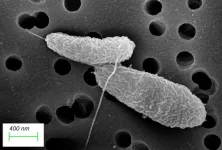(Press-News.org) Many patients with multiple myeloma, a type of blood cancer, eventually develop resistance to one treatment after another. That's in part because cancer stem cells drive the disease -- cells that continually self-renew. If a therapy can't completely destroy these malignant stem cells, the cancer is likely to keep coming back.
Researchers at University of California San Diego School of Medicine and Ionis Pharmaceuticals are taking a new, targeted approach to myeloma treatment -- silencing IRF4, a gene that allows myeloma stem cells and tumor cells to proliferate and survive. Past studies have shown that high IRF4 levels are associated with lower overall survival rates for patients with the disease.
In a study published January 20, 2021 in Cell Stem Cell, the team details their successes inhibiting IRF4 with an antisense oligonucleotide, an engineered piece of DNA specifically designed to bind the genetic material coding for IRF4, causing it to degrade. The oligonucleotide -- an investigational antisense medicine developed by Ionis and known as ION251 -- lowered disease burden, reduced myeloma stem cell abundance and increased survival of mice bearing human myeloma, according to preclinical study data.
Authors say the results support a Phase I clinical trial recently launched to assess the safety and efficacy of ION251 to treat humans with myeloma.
"As scientists, we don't usually have direct contact with patients, as a daily reminder of what our research could do, or why it's important," said co-senior author Leslie Crews, PhD, assistant professor in the Division of Regenerative Medicine at UC San Diego School of Medicine. "But I've been working with a local support group for patients with multiple myeloma. They inspire me. They ask the most insightful questions, and it really makes it personal. I hope this work will eventually give them new potential treatments to prevent relapse, and ultimately get better."
UC San Diego School of Medicine and Ionis Pharmaceuticals have a long history of collaborating on the development of investigational antisense medicines. Several Ionis antisense drugs have been commercially approved, including the U.S. Food and Drug Administration (FDA)-approved SPINRAZA, a therapy for spinal muscular atrophy. In addition, several other therapies are currently in clinical trials.
One challenge myeloma researchers face is that myeloma cells don't grow well in laboratory dishes. To study the disease and test new treatments, the best method, Crews said, is to transplant human myeloma cells into mice that lack an immune system and thus won't reject the human cells -- making avatars of each unique patient, in a way.
The team tested ION251 on these myeloma mouse avatars. Compared to untreated mice, the treated mice had significantly fewer myeloma cells after two to six weeks of treatment. What's more, 70 to 100 percent of the treated mice survived, whereas none of the untreated control mice did. There were 10 mice in each treatment or control group and they received daily doses of ION251 or a control for one week, followed by three doses per week.
In separate experiments using human cells isolated from myeloma or healthy donor samples, doses of ION251 used were enough to eradicate the myeloma stem cells while sparing healthy blood cells.
"The results of these preclinical studies were so striking that half the microscopy images we took to compare bone marrow samples between treated and untreated mice kept coming back blank -- in the treated mice, we couldn't find any myeloma cells left for us to study," said Crews, who is also associate member of the Moores Cancer Center and member of the Altman Clinical and Translational Research Institute at UC San Diego. "It makes the science more difficult, but it gives me hope for patients."
In addition to working on its own, the treatment improved myeloma tumor cell sensitivity to standard-of-care cancer therapeutics. The researchers also drilled down to the mechanisms at play and described the molecular effects of IRF4 inhibition -- information that both clarifies how myeloma forms in the first place, and how the treatment works.
"These proof-of-principle studies will enable rapid clinical development of anti-sense oligonucleotide-mediated IRF4 inhibition to prevent myeloma relapse driven by drug-resistant cancer stem cells," said co-senior author Catriona Jamieson, MD, PhD, Koman Family Presidential Endowed Chair in Cancer Research, deputy director of Moores Cancer Center, director of the Sanford Stem Cell Clinical Center and director of the CIRM Alpha Stem Cell Clinic at UC San Diego Health.
The Phase I clinical trial to assess the safety of ION251, sponsored by Ionis Pharmaceuticals, is now recruiting participants at Moores Cancer Center at UC San Diego Health and elsewhere. More information is available at clinicaltrials.gov/ct2/show/NCT04398485.
"This collaboration exemplifies the power of combining Ionis' antisense technology to target previously un-druggable factors in cancer, with world-class academic, translational and clinical research from institutions such as UC San Diego to rapidly bring promising drugs to patients desperately in need," said co-senior author A. Robert MacLeod, PhD, vice president and franchise head of Oncology at Ionis Pharmaceuticals.
According to the National Cancer Institute, multiple myeloma is the second most common blood cancer in the United States, with more than 32,000 new cases predicted in 2020 and a five-year survival of only 53.9 percent.
INFORMATION:
Additional co-authors of the study include: Phoebe K. Mondala, Ashni A. Vora, Elisa Lazzari, Luisa Ladel, Caitlin Costello, UC San Diego; Tianyuan Zhou, Xiaolin Luo, and Youngsoo Kim, Ionis Pharmaceuticals.
Attine ants are farmers, and they grow fungus as food. Pseudonocardia and Streptomyces bacteria are their farmhands, producing metabolites that protect the crop from pathogens. Surprisingly, these metabolites lack common structural features across bacteria from different geographic locations, even though the ants share a common ancestor. Now, researchers report in ACS Central Science they have identified the first shared antifungal compound among many of these bacteria across Brazil. The compound could someday have medical applications.
Attine ants originated as one species at a single location in the Amazon 50 million years ago. They have evolved to 200 species that have spread their farming practices ...
Renewable energy sources, such as wind and solar power, could help decrease the world's reliance on fossil fuels. But first, power companies need a safe, cost-effective way to store the energy for later use. Massive lithium-ion batteries can do the job, but they suffer from safety issues and limited lithium availability. Now, researchers reporting in ACS' Nano Letters have made a prototype of an anode-free, zinc-based battery that uses low-cost, naturally abundant materials.
Aqueous zinc-based batteries have been previously explored for grid-scale energy storage ...
ROCHESTER, Minn. -- Approximately 1.5 million heart attacks and strokes occur every year in men and women in the U.S. Sex and age play a large part in who experiences a heart attack, the methods used to treat these heart attacks, and the eventual post hospital outcomes of the people who experience heart attacks. Mayo Clinic researchers discuss these sex and age differences in study findings published in Mayo Clinic Proceedings.
In this study, Mayo Clinic researchers wanted to see if age was a key factor in sex-related differences in patients with a heart attack. Using public all-payer hospitalization data from the Nationwide Inpatient Sample, the team of researchers ...
New research led by BirdLife International, the University of East Anglia (UEA) and British Antarctic Survey highlights how a proposed network of marine protected areas could help safeguard some of the most important areas at sea for breeding Antarctic penguins.
The findings, published today in the journal Frontiers in Marine Science, show that if all the Marine Protected Areas (MPAs) proposed around Antarctica were adopted, the permanent conservation of high-quality areas for a flagship group of Antarctic wildlife - the penguins - would increase by between 49% and 100% depending on the species.
The Southern Ocean surrounding Antarctica is home to thousands of unique species, including seals, whales and four species ...
CLEVELAND, Ohio (Jan. 20, 2021)--Hot flashes, insomnia, and vaginal dryness are commonly reported symptoms that accompany the menopause transition. A new study suggests that such symptoms--especially psychological and sexual problems--are worse for women who have premature ovarian insufficiency (POI) than for women undergoing natural menopause. Study results are published online today in Menopause, the journal of The North American Menopause Society (NAMS).
Premature ovarian insufficiency is defined as the cessation of ovarian function that leads to menopause before the age of 40 years. The ...
A 15-year research and advocacy effort to make microwave ovens safer has led to a change in national manufacturing standards that will make microwaves more difficult for young children to open, protecting them from the severe microwave-related burns that scar hundreds of kids under 5 years old in the United States each year. Researchers at Rush University Medical Center and other leaders of the campaign, who worked diligently to document the frequency and severity of these injuries and young children's vulnerability to them, published the results of their efforts in The Journal of Pediatrics ...
January 20, 2021 - Plant breeders are constantly working to develop new bean varieties to meet the needs and desires of the food industry. But not everyone wants the same thing.
Many consumers desire heirloom-type beans, which have great culinary quality and are visually appealing. On the other hand, farmers desire beans with better END ...
Scientists have discovered how bacteria commonly responsible for seafood-related stomach upsets can go dormant and then "wake up".
Vibrio parahaemolyticus is a marine bacterium that can cause gastroenteritis in humans when eaten in raw or undercooked shellfish such as oysters and mussels.
Some of these bacteria are able to turn dormant in poor growth conditions such as cold temperatures - and can remain in that state of hibernation for long periods before resuscitating.
University of Exeter scientists have identified a population of these dormant cells that are better at waking up, and have discovered an enzyme involved in that waking up process.
"Most of these bacteria die when they encounter poor growth conditions, but we identified sub-populations ...
BEER-SHEVA, Israel...January 20, 2021 -Ben-Gurion University of the Negev researchers have discovered that the protein BMP5/7 offers promising therapeutics that could slow down or halt the progression of Parkinson's disease.
The findings were published in the prestigious clinical neurology journal, END ...
A new negative pressure ventilator which could provide additional treatment options for patients with respiratory failure, including those with COVID-19 - and whose design can be easily adapted to developing countries - has been created by a team that includes anaesthetists, nurses and engineers. Details on the new exovent system - which is similar in design but much smaller in scale and easier to use than the devices used to help treat polio patients during the 1950s - are published in Anaesthesia (a journal of the Association of Anaesthetists).
Use of this system ...

